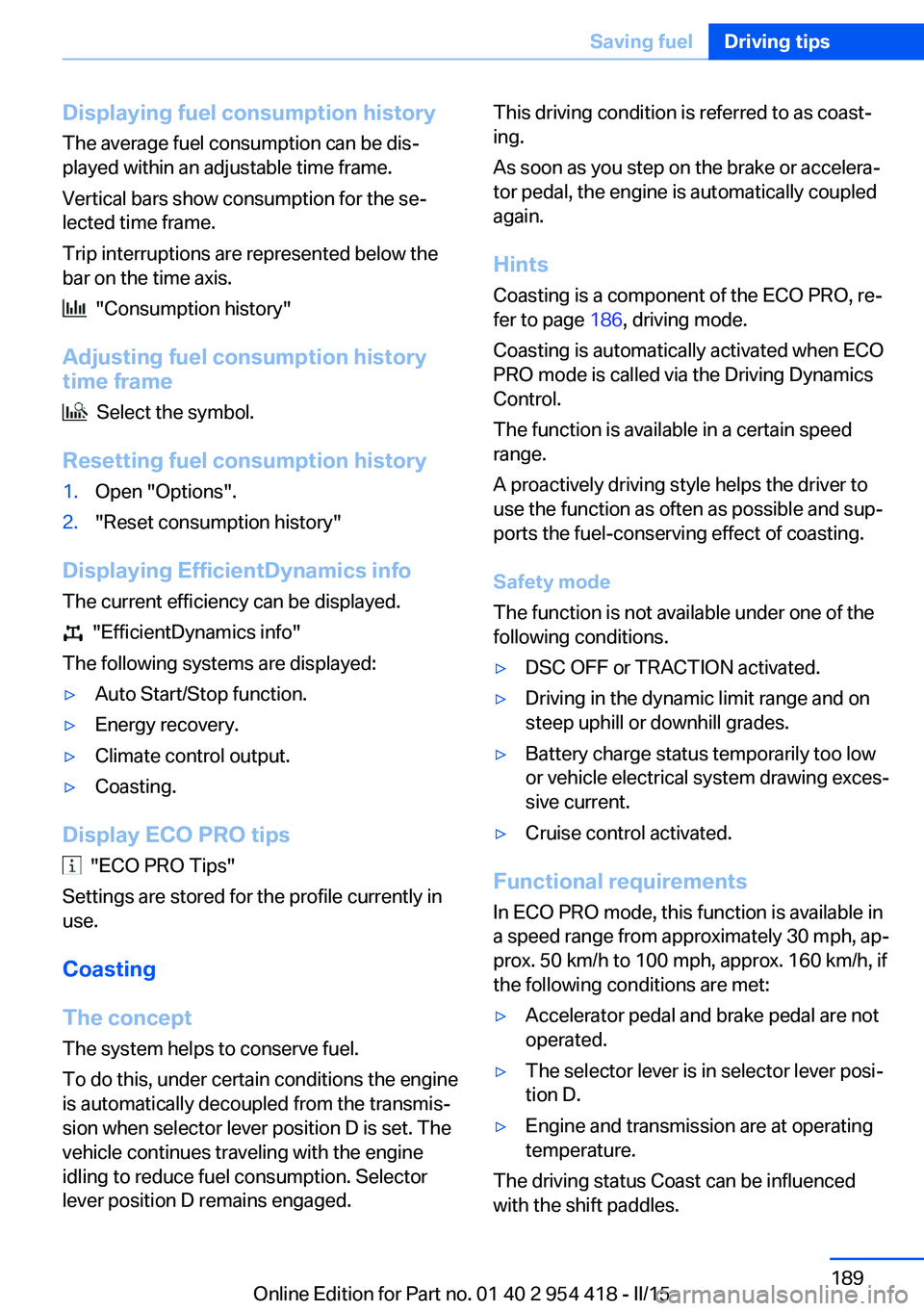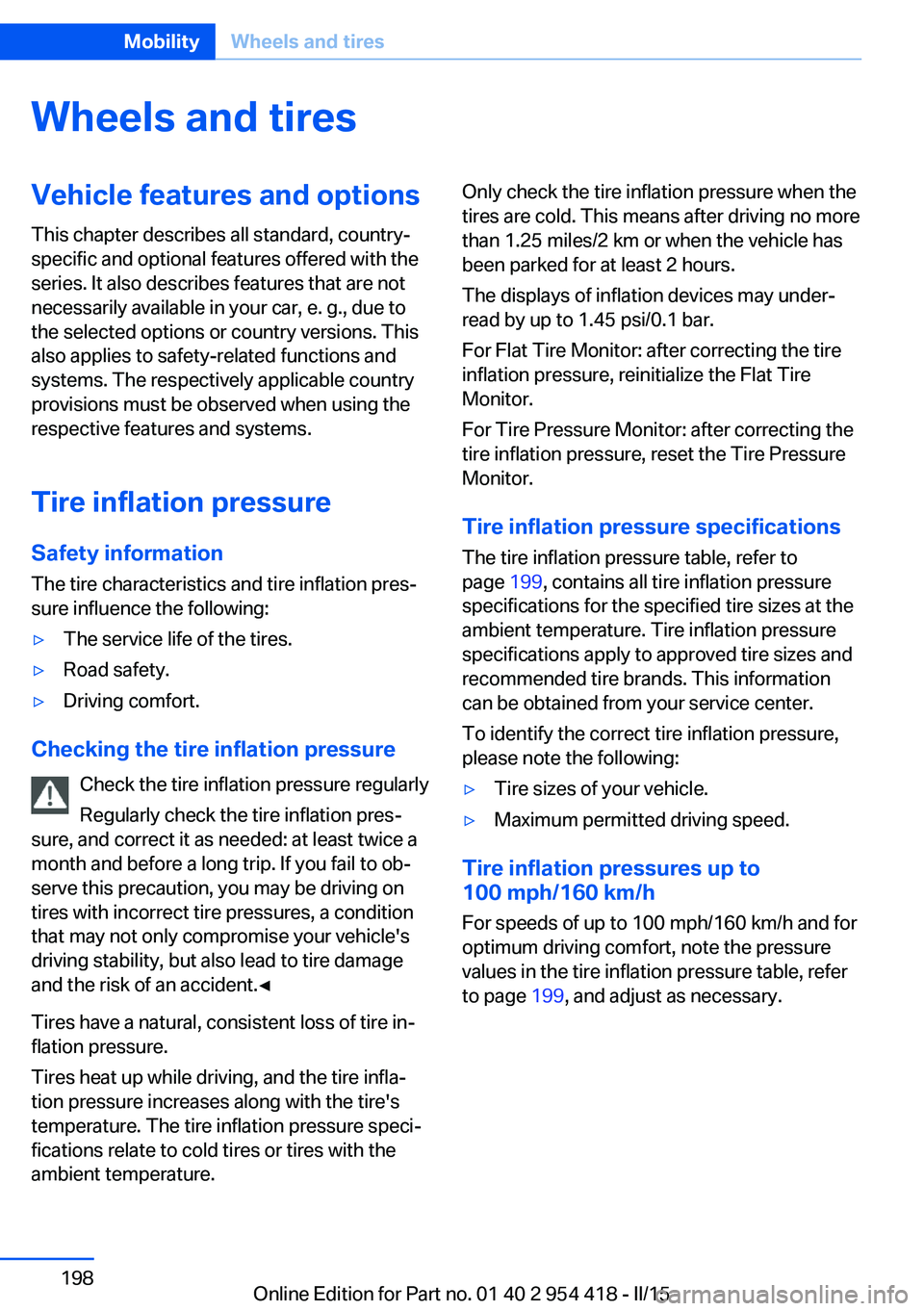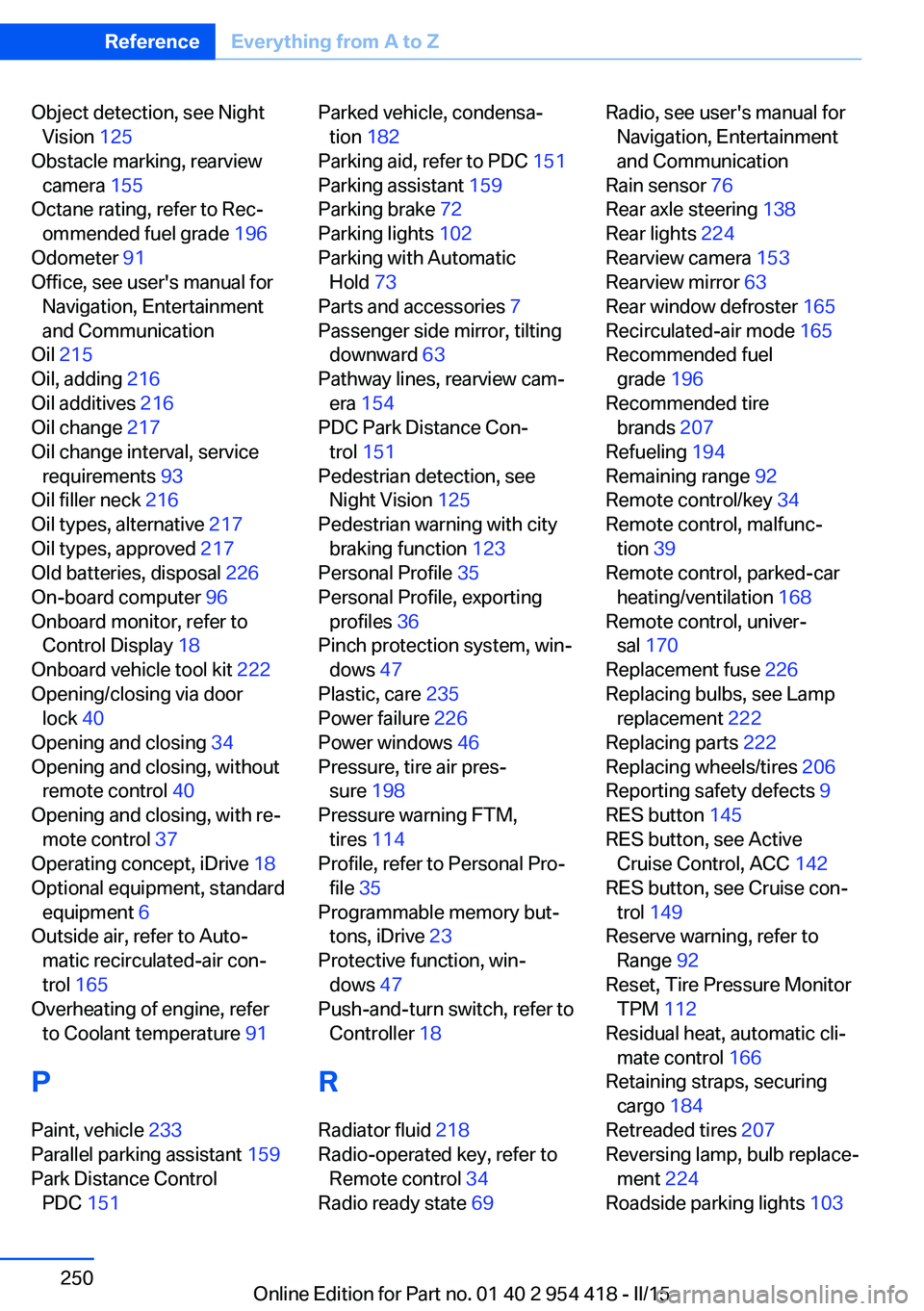2015 BMW 650I CONVERTIBLE reset
[x] Cancel search: resetPage 193 of 259

Displaying fuel consumption history
The average fuel consumption can be dis‐
played within an adjustable time frame.
Vertical bars show consumption for the se‐
lected time frame.
Trip interruptions are represented below the
bar on the time axis.
"Consumption history"
Adjusting fuel consumption history time frame
Select the symbol.
Resetting fuel consumption history
1.Open "Options".2."Reset consumption history"
Displaying EfficientDynamics info
The current efficiency can be displayed.
"EfficientDynamics info"
The following systems are displayed:
▷Auto Start/Stop function.▷Energy recovery.▷Climate control output.▷Coasting.
Display ECO PRO tips
"ECO PRO Tips"
Settings are stored for the profile currently in
use.
Coasting
The concept
The system helps to conserve fuel.
To do this, under certain conditions the engine
is automatically decoupled from the transmis‐
sion when selector lever position D is set. The
vehicle continues traveling with the engine
idling to reduce fuel consumption. Selector
lever position D remains engaged.
This driving condition is referred to as coast‐
ing.
As soon as you step on the brake or accelera‐
tor pedal, the engine is automatically coupled
again.
Hints
Coasting is a component of the ECO PRO, re‐
fer to page 186, driving mode.
Coasting is automatically activated when ECO
PRO mode is called via the Driving Dynamics
Control.
The function is available in a certain speed
range.
A proactively driving style helps the driver to
use the function as often as possible and sup‐
ports the fuel-conserving effect of coasting.
Safety mode
The function is not available under one of the
following conditions.▷DSC OFF or TRACTION activated.▷Driving in the dynamic limit range and on
steep uphill or downhill grades.▷Battery charge status temporarily too low
or vehicle electrical system drawing exces‐
sive current.▷Cruise control activated.
Functional requirements
In ECO PRO mode, this function is available in
a speed range from approximately 30 mph, ap‐
prox. 50 km/h to 100 mph, approx. 160 km/h, if
the following conditions are met:
▷Accelerator pedal and brake pedal are not
operated.▷The selector lever is in selector lever posi‐
tion D.▷Engine and transmission are at operating
temperature.
The driving status Coast can be influenced
with the shift paddles.
Seite 189Saving fuelDriving tips189
Online Edition for Part no. 01 40 2 954 418 - II/15
Page 202 of 259

Wheels and tiresVehicle features and options
This chapter describes all standard, country-
specific and optional features offered with the
series. It also describes features that are not
necessarily available in your car, e. g., due to
the selected options or country versions. This
also applies to safety-related functions and
systems. The respectively applicable country
provisions must be observed when using the
respective features and systems.
Tire inflation pressure Safety information
The tire characteristics and tire inflation pres‐
sure influence the following:▷The service life of the tires.▷Road safety.▷Driving comfort.
Checking the tire inflation pressure
Check the tire inflation pressure regularly
Regularly check the tire inflation pres‐
sure, and correct it as needed: at least twice a
month and before a long trip. If you fail to ob‐
serve this precaution, you may be driving on
tires with incorrect tire pressures, a condition
that may not only compromise your vehicle's
driving stability, but also lead to tire damage
and the risk of an accident.◀
Tires have a natural, consistent loss of tire in‐
flation pressure.
Tires heat up while driving, and the tire infla‐
tion pressure increases along with the tire's
temperature. The tire inflation pressure speci‐
fications relate to cold tires or tires with the
ambient temperature.
Only check the tire inflation pressure when the
tires are cold. This means after driving no more
than 1.25 miles/2 km or when the vehicle has
been parked for at least 2 hours.
The displays of inflation devices may under-
read by up to 1.45 psi/0.1 bar.
For Flat Tire Monitor: after correcting the tire
inflation pressure, reinitialize the Flat Tire
Monitor.
For Tire Pressure Monitor: after correcting the
tire inflation pressure, reset the Tire Pressure
Monitor.
Tire inflation pressure specifications
The tire inflation pressure table, refer to
page 199, contains all tire inflation pressure
specifications for the specified tire sizes at the
ambient temperature. Tire inflation pressure
specifications apply to approved tire sizes and
recommended tire brands. This information
can be obtained from your service center.
To identify the correct tire inflation pressure,
please note the following:▷Tire sizes of your vehicle.▷Maximum permitted driving speed.
Tire inflation pressures up to
100 mph/160 km/h
For speeds of up to 100 mph/160 km/h and for
optimum driving comfort, note the pressure
values in the tire inflation pressure table, refer
to page 199, and adjust as necessary.
Seite 198MobilityWheels and tires198
Online Edition for Part no. 01 40 2 954 418 - II/15
Page 254 of 259

Object detection, see NightVision 125
Obstacle marking, rearview camera 155
Octane rating, refer to Rec‐ ommended fuel grade 196
Odometer 91
Office, see user's manual for Navigation, Entertainment
and Communication
Oil 215
Oil, adding 216
Oil additives 216
Oil change 217
Oil change interval, service requirements 93
Oil filler neck 216
Oil types, alternative 217
Oil types, approved 217
Old batteries, disposal 226
On-board computer 96
Onboard monitor, refer to Control Display 18
Onboard vehicle tool kit 222
Opening/closing via door lock 40
Opening and closing 34
Opening and closing, without remote control 40
Opening and closing, with re‐ mote control 37
Operating concept, iDrive 18
Optional equipment, standard equipment 6
Outside air, refer to Auto‐ matic recirculated-air con‐
trol 165
Overheating of engine, refer to Coolant temperature 91
P Paint, vehicle 233
Parallel parking assistant 159
Park Distance Control PDC 151 Parked vehicle, condensa‐
tion 182
Parking aid, refer to PDC 151
Parking assistant 159
Parking brake 72
Parking lights 102
Parking with Automatic Hold 73
Parts and accessories 7
Passenger side mirror, tilting downward 63
Pathway lines, rearview cam‐ era 154
PDC Park Distance Con‐ trol 151
Pedestrian detection, see Night Vision 125
Pedestrian warning with city braking function 123
Personal Profile 35
Personal Profile, exporting profiles 36
Pinch protection system, win‐ dows 47
Plastic, care 235
Power failure 226
Power windows 46
Pressure, tire air pres‐ sure 198
Pressure warning FTM, tires 114
Profile, refer to Personal Pro‐ file 35
Programmable memory but‐ tons, iDrive 23
Protective function, win‐ dows 47
Push-and-turn switch, refer to Controller 18
R Radiator fluid 218
Radio-operated key, refer to Remote control 34
Radio ready state 69 Radio, see user's manual for
Navigation, Entertainment
and Communication
Rain sensor 76
Rear axle steering 138
Rear lights 224
Rearview camera 153
Rearview mirror 63
Rear window defroster 165
Recirculated-air mode 165
Recommended fuel grade 196
Recommended tire brands 207
Refueling 194
Remaining range 92
Remote control/key 34
Remote control, malfunc‐ tion 39
Remote control, parked-car heating/ventilation 168
Remote control, univer‐ sal 170
Replacement fuse 226
Replacing bulbs, see Lamp replacement 222
Replacing parts 222
Replacing wheels/tires 206
Reporting safety defects 9
RES button 145
RES button, see Active Cruise Control, ACC 142
RES button, see Cruise con‐ trol 149
Reserve warning, refer to Range 92
Reset, Tire Pressure Monitor TPM 112
Residual heat, automatic cli‐ mate control 166
Retaining straps, securing cargo 184
Retreaded tires 207
Reversing lamp, bulb replace‐ ment 224
Roadside parking lights 103 Seite 250ReferenceEverything from A to Z250
Online Edition for Part no. 01 40 2 954 418 - II/15